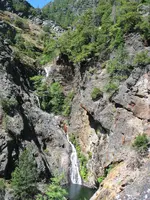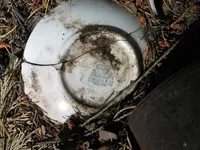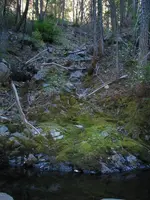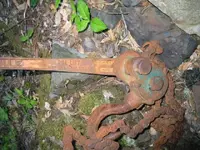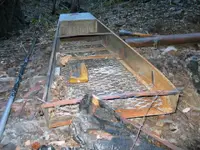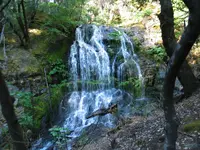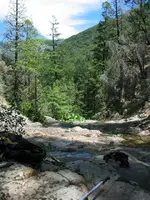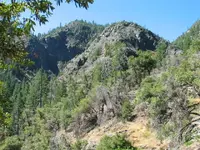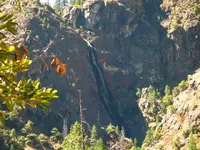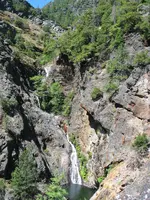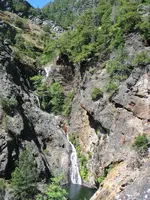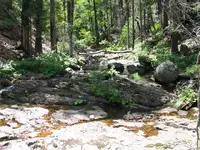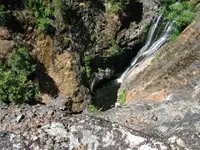63bkpkr
Silver Member
- Joined
- Aug 9, 2007
- Messages
- 4,069
- Reaction score
- 4,628
- Golden Thread
- 0
- Location
- Southern California
- Detector(s) used
- XLT, GMT, 6000D Coinmaster
- Primary Interest:
- All Treasure Hunting
- #1
Thread Owner
Trip & Results with modification to A52 sluice
Hello fellow gold seekers,
On 20 Sept I found myself going down the side wall of a canyon on my way to my favorite river and prospecting site with my modified A52 sluice. The weather was mild as three days of storm clouds had just finished going through, the mild temperatures were appreciated as the pack weighed out around 80 lbs.
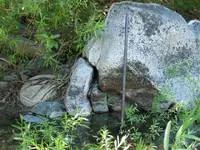
The picture was taken by me shortly after I arrived at the camp site so the sweat is still running down my back. Yes, I carried all of that in just as you see it save for the insurance policy I carry which is on a rock on the ground on the left side of the picture. It is amazing how those "oh I will just throw this in for fun" things add up quickly to 80 lbs. Note the latest in High Tech Camp water bottles, that's the white looking jug on the side of the pack, waste not want not.
The next picture shows the prospecting site before I started working it.
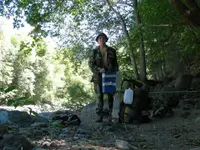
The next picture shows the prospecting site on 20 Sept as I had left it a few weeks back. Note that the left side has been back filled with boulders.
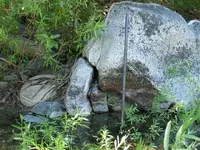
The camp fire on the first night was really inviting as the temperatures in the sierras are falling quickly in the evenings. The mornings were flat out cold! Note the buckets in the background at the prospecting site on the other side of the river.
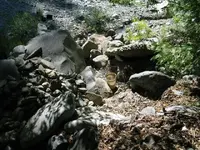
Tuesday morning found the sluice modification being put to work in the river. The modification was to add the two support bars at the rear of the flare so the sifter would be held but could still be moved back and forth to wash the raw material being put into the sifter. The previous method of sifting the ore is on either side of the sluice, they are the 5 gallon bucket and the modified mesh waste paper basket. The bucket/waste basket works well but any amount over two shovels full really taxes the back. The sifter being mounted on the back of the sluice takes two small shovels full of raw material. This worked ok as long as I suported myslef with one hand on the rocks as the sifter was moved back and forth. Otherwise the back saw way too much strain. After using this system I've decided to add an 8" extension to the flare so the sifter mount is further away from the stock black matting to eliminate some of the turbulence of the water contacting the mount bars.
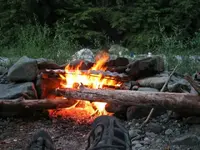
The next picture shows the sluice ready to have the concentrates washed down into the concentrates bucket. Note that the bucket is rectangular, that an A52 fits all the way to the bottom of the bucket Without Forcing the Sides of the Bucket out and even when washing just the aluminium part of the sluice down does not require that the spring side clamps be attached to the side walls, they just swing in as the bottom of the sluice pan slides into the bucket. An A52 Does Not Properly fit into a 5 gallon bucket and if it goes in too far it can split the sides of a 5 gal. bucket. The blue recycle bucket cost less than the black bucket of the same size and it can be found easier at the site.
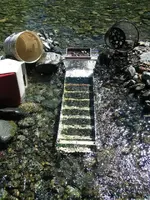
My prospecting site has one sad quirk, it floods when digging into the floor or side walls close to the floor of the trench. In the picture I've dug down in the center of the trench as well as under the forward rock on the floor of the trench which led me to dig under the main boulder on the right. I thought I was going to be in Gravy as under the main boulder there was lots of clay and further towards the right mucky/heavy rotting material. I found No Gold in the clay or muck! The clay was moist but thick and took some mushing to get it to disolve in water. To be able to see what I'm doing I have to bucket the water out and work quickly as it refills in ~ 5 minutes. The picture shows clear water before I've touched it, touch it and the whole pool clouds because of the silt.
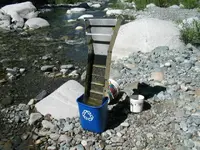
With no gold found in the center or the far right I tried to dry the area some by fillin it in with dry dirt. With that done I moved to the left side of the trench. I started digging in front of the dark grey rock and found a little gold, after two test digs and getting nothing on the second one I moved further to the right. Test dig and move further to the right till I test dug in front of the large pale grey rock and that is where I obtained the first good gold of the trip
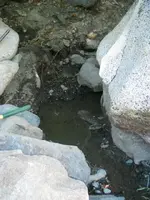
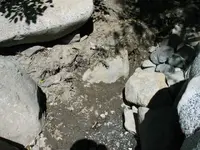
The first good gold was found along the lower front edge of the boulder in picture above but again it was near the floor level. I dug again in that area but that one pocket of color was all that was there. I checked out removing the boulder but it was sunk deep into the floor so I had to let it go.
Here's a picture of all the gold found from this trip. The cube shaped item is an Iron Pyrite (fools gold) crystal that has oxidized and to the right of it is a small shotgun pellet, grey from oxidation. I also found a perfect lead .22 slug, probably shot into the water and was never deformed.
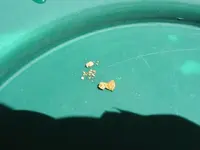
Now was time to shut the site down and that meant filling in the other half of the site with boulders, any volunteers out there?? Ok just me but I got it done. I wanted to fill it in as I'd disturbed several main boulders and without filling I felt the hillside would be removed in the 2011 spring floods/melt runoff. With large boulders in the bottom and various sized ones filling up the rest of the dig above its original height from when I first got there I feel the site will absorb the dirt and rocks the river will throw at it and return to what it looked like originally.
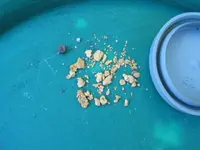
And for a last rememberance of the site that provided me with such interesting learning and exercise, here's me sitting on my rock pile.
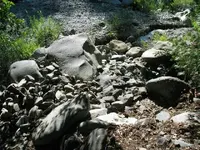
I found the A52 required 4 to 5 cleanouts per 5 gallon bucket of raw material. I tried a variety of positions/angles for the box but found the riffles just filled up quickly with the fines from my ~ 1/4" sifting. The material was fed in slowly, a little time was given between finishing one sample load before the next was put into the sifter and even when I allowed the sluice to sit idle for 20 to 30 minutes the riffles cleared out some but refilled quickly. Maybe I had the sluice too far down into the water but I had a wing dam funneling water into the flare so I had good water flow/velocity. I'd have to say that this sluice requires a lot of work. The blue bucket was a great help in making the task of washing the sluice down much easier than with a round 5 gallon bucket but it was still time lost and more work than I thought it should have been. I'd like to try a McKirk sluice, their #0 Au Trap would be my choice, but that is not likely to happen this year.
but that is not likely to happen this year.
Hello fellow gold seekers,
On 20 Sept I found myself going down the side wall of a canyon on my way to my favorite river and prospecting site with my modified A52 sluice. The weather was mild as three days of storm clouds had just finished going through, the mild temperatures were appreciated as the pack weighed out around 80 lbs.

The picture was taken by me shortly after I arrived at the camp site so the sweat is still running down my back. Yes, I carried all of that in just as you see it save for the insurance policy I carry which is on a rock on the ground on the left side of the picture. It is amazing how those "oh I will just throw this in for fun" things add up quickly to 80 lbs. Note the latest in High Tech Camp water bottles, that's the white looking jug on the side of the pack, waste not want not.
The next picture shows the prospecting site before I started working it.

The next picture shows the prospecting site on 20 Sept as I had left it a few weeks back. Note that the left side has been back filled with boulders.

The camp fire on the first night was really inviting as the temperatures in the sierras are falling quickly in the evenings. The mornings were flat out cold! Note the buckets in the background at the prospecting site on the other side of the river.

Tuesday morning found the sluice modification being put to work in the river. The modification was to add the two support bars at the rear of the flare so the sifter would be held but could still be moved back and forth to wash the raw material being put into the sifter. The previous method of sifting the ore is on either side of the sluice, they are the 5 gallon bucket and the modified mesh waste paper basket. The bucket/waste basket works well but any amount over two shovels full really taxes the back. The sifter being mounted on the back of the sluice takes two small shovels full of raw material. This worked ok as long as I suported myslef with one hand on the rocks as the sifter was moved back and forth. Otherwise the back saw way too much strain. After using this system I've decided to add an 8" extension to the flare so the sifter mount is further away from the stock black matting to eliminate some of the turbulence of the water contacting the mount bars.

The next picture shows the sluice ready to have the concentrates washed down into the concentrates bucket. Note that the bucket is rectangular, that an A52 fits all the way to the bottom of the bucket Without Forcing the Sides of the Bucket out and even when washing just the aluminium part of the sluice down does not require that the spring side clamps be attached to the side walls, they just swing in as the bottom of the sluice pan slides into the bucket. An A52 Does Not Properly fit into a 5 gallon bucket and if it goes in too far it can split the sides of a 5 gal. bucket. The blue recycle bucket cost less than the black bucket of the same size and it can be found easier at the site.

My prospecting site has one sad quirk, it floods when digging into the floor or side walls close to the floor of the trench. In the picture I've dug down in the center of the trench as well as under the forward rock on the floor of the trench which led me to dig under the main boulder on the right. I thought I was going to be in Gravy as under the main boulder there was lots of clay and further towards the right mucky/heavy rotting material. I found No Gold in the clay or muck! The clay was moist but thick and took some mushing to get it to disolve in water. To be able to see what I'm doing I have to bucket the water out and work quickly as it refills in ~ 5 minutes. The picture shows clear water before I've touched it, touch it and the whole pool clouds because of the silt.

With no gold found in the center or the far right I tried to dry the area some by fillin it in with dry dirt. With that done I moved to the left side of the trench. I started digging in front of the dark grey rock and found a little gold, after two test digs and getting nothing on the second one I moved further to the right. Test dig and move further to the right till I test dug in front of the large pale grey rock and that is where I obtained the first good gold of the trip


The first good gold was found along the lower front edge of the boulder in picture above but again it was near the floor level. I dug again in that area but that one pocket of color was all that was there. I checked out removing the boulder but it was sunk deep into the floor so I had to let it go.
Here's a picture of all the gold found from this trip. The cube shaped item is an Iron Pyrite (fools gold) crystal that has oxidized and to the right of it is a small shotgun pellet, grey from oxidation. I also found a perfect lead .22 slug, probably shot into the water and was never deformed.

Now was time to shut the site down and that meant filling in the other half of the site with boulders, any volunteers out there?? Ok just me but I got it done. I wanted to fill it in as I'd disturbed several main boulders and without filling I felt the hillside would be removed in the 2011 spring floods/melt runoff. With large boulders in the bottom and various sized ones filling up the rest of the dig above its original height from when I first got there I feel the site will absorb the dirt and rocks the river will throw at it and return to what it looked like originally.

And for a last rememberance of the site that provided me with such interesting learning and exercise, here's me sitting on my rock pile.

I found the A52 required 4 to 5 cleanouts per 5 gallon bucket of raw material. I tried a variety of positions/angles for the box but found the riffles just filled up quickly with the fines from my ~ 1/4" sifting. The material was fed in slowly, a little time was given between finishing one sample load before the next was put into the sifter and even when I allowed the sluice to sit idle for 20 to 30 minutes the riffles cleared out some but refilled quickly. Maybe I had the sluice too far down into the water but I had a wing dam funneling water into the flare so I had good water flow/velocity. I'd have to say that this sluice requires a lot of work. The blue bucket was a great help in making the task of washing the sluice down much easier than with a round 5 gallon bucket but it was still time lost and more work than I thought it should have been. I'd like to try a McKirk sluice, their #0 Au Trap would be my choice,
 but that is not likely to happen this year.
but that is not likely to happen this year.


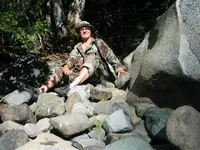

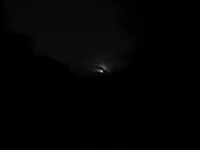


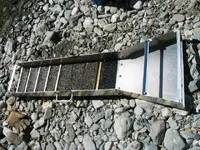

 alot of people your age are fata$$es sitting and doing less alot of people my age are even worse as th Aussies say " good on ya" soooo think of it how did the gold your digging get where it is? while the river/creek was at flood stage, wich is the ONLY time gold the size youre recovering is moving...gold that is moving in the creek if not at the bottom quickly gets to the bottom and keeps moving until it hits a trap or low preassure zone and slows and stops.if you were to drop some gold into that racing slurry in that creek/river the gold would quickly work its way down.Your sluice is that river/creek minimized the physics stay the same the gold traps are absolutely predictable unlike in the river /creek. so as long as you see the light color material dancing around your good... put your finger behind a riffle you will feel how loose and suspended the material is...if the material behind the riffle feels packed it might be time to clean up or if your seeing black sand building up on top of light sand its absolutely time to clean up. i dont recomend ever having the majority of your sluice walls under the waters surface.. your losing the velocity vs. cfm that helps the sluice do what it does. actually you shold see the effects the riffles have on the water i.e. " bumps" on the surface of the water. one inch of drop per foot and the depth of the water over the riffle about the same as the height of the riffle..if your worried about gold loss and "kiteing" ( is that a word?) and gold loss dig your tailings and rerun them cause any gold you lost didnt go past there..i gaurantee youll never worry about it again. 8)
alot of people your age are fata$$es sitting and doing less alot of people my age are even worse as th Aussies say " good on ya" soooo think of it how did the gold your digging get where it is? while the river/creek was at flood stage, wich is the ONLY time gold the size youre recovering is moving...gold that is moving in the creek if not at the bottom quickly gets to the bottom and keeps moving until it hits a trap or low preassure zone and slows and stops.if you were to drop some gold into that racing slurry in that creek/river the gold would quickly work its way down.Your sluice is that river/creek minimized the physics stay the same the gold traps are absolutely predictable unlike in the river /creek. so as long as you see the light color material dancing around your good... put your finger behind a riffle you will feel how loose and suspended the material is...if the material behind the riffle feels packed it might be time to clean up or if your seeing black sand building up on top of light sand its absolutely time to clean up. i dont recomend ever having the majority of your sluice walls under the waters surface.. your losing the velocity vs. cfm that helps the sluice do what it does. actually you shold see the effects the riffles have on the water i.e. " bumps" on the surface of the water. one inch of drop per foot and the depth of the water over the riffle about the same as the height of the riffle..if your worried about gold loss and "kiteing" ( is that a word?) and gold loss dig your tailings and rerun them cause any gold you lost didnt go past there..i gaurantee youll never worry about it again. 8)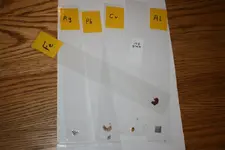
 say what?? I am NOT knocking the amount--just the method and ifn' ya backed off the extensive cleanups(simply more angle to your drop would fix it) you'd get MUCH more gold as in all mining the more ya move ---the more ya make--a simple equation. Soooooooooo not throwing a wet blanket just a simple aside---tons a au 2 u2 -John--PS. After 2 years of LL gettn' elbows rebuilt I'm now working on getting fit for a new knee so I can pass you on the trail hiking again and 2 years ago I lost 35+ pounds and WHAT a difference in mobility. Kudos once again to any guy over 55 who is still out there a diggn', hiking and mining
say what?? I am NOT knocking the amount--just the method and ifn' ya backed off the extensive cleanups(simply more angle to your drop would fix it) you'd get MUCH more gold as in all mining the more ya move ---the more ya make--a simple equation. Soooooooooo not throwing a wet blanket just a simple aside---tons a au 2 u2 -John--PS. After 2 years of LL gettn' elbows rebuilt I'm now working on getting fit for a new knee so I can pass you on the trail hiking again and 2 years ago I lost 35+ pounds and WHAT a difference in mobility. Kudos once again to any guy over 55 who is still out there a diggn', hiking and mining 